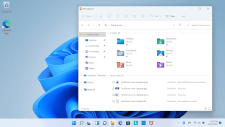Windows 11
Windows 11 is a major version of the Microsoft Windows operating system. It was released on October 5, 2021, and follows Windows 10, the previous version of Windows, released in 2015.
The Windows 11 user interface is similar to Windows 10 but includes several minor changes. For example, the task bar, left-aligned since Windows 95, is centered by default. Windows have slightly rounded corners (like macOS and a subtle blurred translucent effect. "Snap Layouts" make it easy to organize multiple windows in a preset grid.
Widgets in Windows 11 provide a quick way to view frequently-accessed information, such as weather, calendar events, and to-do lists. Chat from Microsoft Teams is integrated into the OS, making it easy to connect with other users. The Microsoft Store provides a simple way to find and download applications.
Windows 11 is a desktop operating system, meaning it is designed to run on desktop and laptop computers. While it is not a mobile OS, Windows 11 supports touchscreen input, available on many Windows machines. It also supports several "touch gestures" for scrolling, zooming, and hiding and showing windows.
The Windows 11 system requirements at the time of launch are:
- CPU: 1 GHz or faster 64-bit processor (such as an Intel or AMD x86 CPU)
- GPU: Graphics card or integrated processor compatible with DirectX 12 or later
- RAM: 4 GB or more
- Storage: 64 GB storage device or larger
- Other hardware: Trusted Platform Module (TPM) chip, Secure Boot capable firmware
- Additional requirements: Internet connectivity, Microsoft account
 Test Your Knowledge
Test Your Knowledge